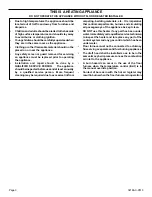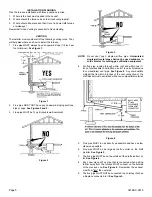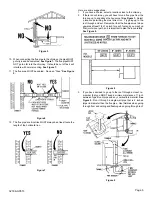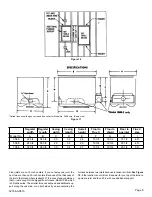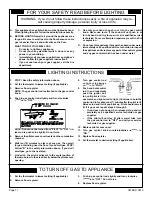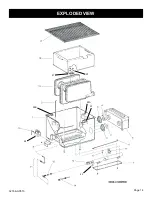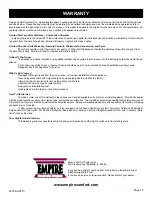
32186-0-0513
Page 12
Figure 16
The correct pilot flame will be blue and extend past the thermopile
as shown in the drawing. LP gas models do not require adjusting.
The input of Natural gas models will require adjusting if the inlet
pressure to the valve is above 5" w.c.
pROpER MAIN bURNER FLAME
5088, 7088
B
A
C
Figure 17
Inner Cone
Outer Cone Carry down flame
Model
Gas
(A) Dark blue (B) Light blue (C) Blue
7088
Nat
1 inch
2 1/2 inches 1/4 inch
LP
3/4 inch
2 inches
small cone
5088
Nat.
3/4 inch
2 inches
3/16 inch
LP
1/2 inch
1 1/2 inch
small cone
DO NOT MISTAkE AN ORANGE FLAME CAUSED BY PARTICLES
IN THE AIR FOR THE UNDESIRABLE YELLOW FLAME.
FLAME 360° AROUND
GENERATOR - COMING
TO TOP OF GENERATOR
Figure 18
pROpER pILOt bURNER FLAME 5088, 7088
A blue flame shooting toward the main burner with an inner blue
cone and a larger light blue outer flame. The generator will be sur
-
rounded by a blue flame that terminates near the top of the generator.
HIGH ALtItUdEs
Orifice size must be reduced for high altitude use, or carbon monoxide
may be generated and excessive heat will seriously damage the unit.
When altitudes over 2,000 feet are specified, in the United States,
main burner spuds will be furnished to reduce input 4% for each
1,000 feet of altitude above sea level. Contact the manufacturer
or your gas company before changing spud sizes.
CHECkING MANIFOLd pREssURE
Both Propane and Natural gas valves have a built-in pressure
regulator in the gas valve with factory-set adjustment. Natural gas
models should have a manifold pressure of approximately 3.5"
w.c. at the valve outlet with the inlet pressure to the valve from a
minimum of 5.0" w.c. for the purpose of input of input adjustment to
a maximum of 7.0" w.c. Propane gas models will have a manifold
pressure approximately 10.0" w.c. at the valve outlet with the inlet
pressure to the valve from a minimum of 11.0" w.c. for the purpose
of input adjustment to a maximum of 13.0" w.c.
An 1/8" N.P.T. plugged tapping, accessible for test gage connection,
is located on the outlet side of the gas control.
CLEANING tHE MAIN bURNER
Remove the burner and apply air pressure inside the throat of the
burner and down into the ports.
Check for proper burner and pilot flame before and during each
heating season.
sERvICING
INstALLAtION ANd REpAIR sHOULd bE dONE bY A qUALI-
FIEd sERvICE pERsON.
The appliance should be inspected
before use and at least annually by a professional service person.
More frequent cleaning may be required due to excessive lint from
carpeting, bedding material, etc. It is imperative that control compart-
ments, burners and circulating air passageways of the appliance
be kept clean.
Floor furnace must not be connected to a chimney flue servicing
a separate solid-fuel burning appliance.
dON't
put anything around the furnace that will obstruct the
flow of combustion and ventilation air.
DO keep the appliance area clear and free from combustible
material, gasoline and other flammable vapors and liquids.
DO examine venting system periodically and replace damaged
parts.
DO examine burners periodically. Clean and replace damaged
parts.
MAkE
periodic visual check of pilot and burner flame.



